In the sprawling landscapes of Texas, a dazzling array of herons takes center stage, contributing to the state’s rich avian tapestry.
Encounter the 12 Herons of Texas, where diverse habitats, from coastal marshes to inland wetlands, host an exquisite cast of these elegant waders.
Each species plays a unique role in the intricate web of Texas’s ecosystems, from the majestic Great Blue Heron to the agile Tricolored Heron.
This exploration delves into these avian inhabitants’ distinctive features, behaviors, and habitats, offering bird enthusiasts and nature lovers a curated glimpse into the captivating world of Texas’s heron diversity.
Join us on a virtual journey through the Lone Star State, where the graceful movements and vibrant plumage of the 12 Herons of Texas unfold against a backdrop of natural splendor. Stay sharp.
12 Herons of Texas
In Texas’s diverse wetlands and coastal landscapes, a remarkable array of herons grace the skies and waters, each species contributing uniquely to the intricate balance of local ecosystems.
From the dynamic foraging techniques of the Reddish Egret to the cooperative associations of the Cattle Egret, these avian inhabitants play vital roles, showcasing the resilience and adaptability of Texas’s vibrant birdlife.
1. Great Egret
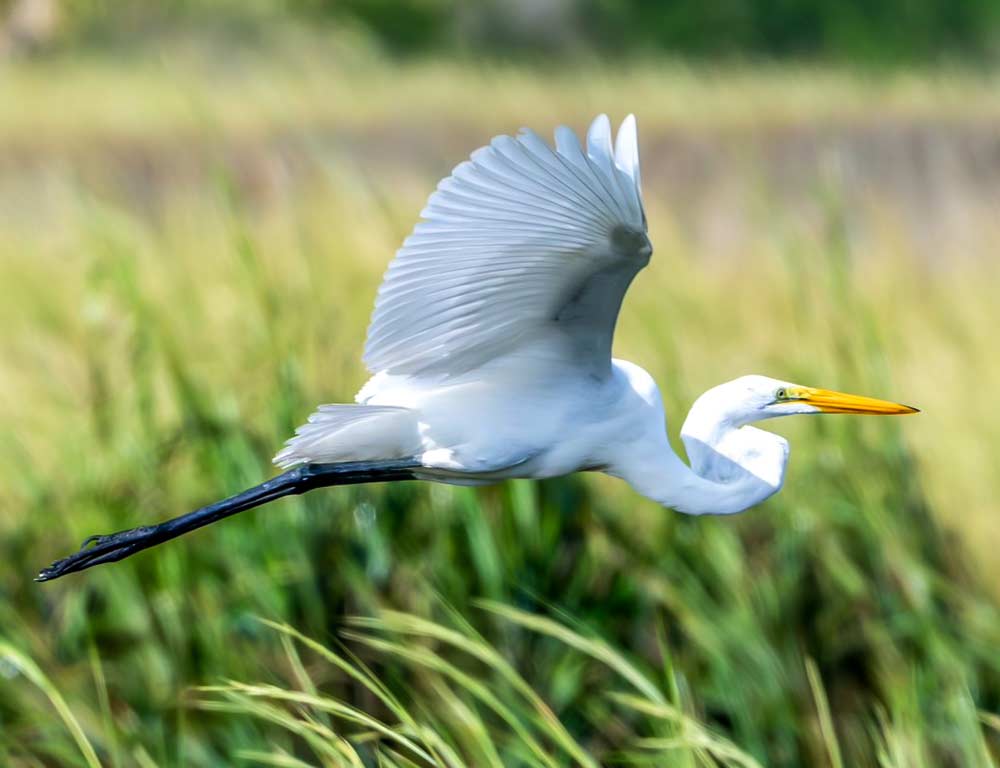
- Scientific Name: Ardea alba
- Population: Abundant in Texas
- Life Span: Up to 15 years
- Size: 37-41 inches
- Weight: 2.2-3.6 pounds
- Food: Fish, frogs, small mammals, and insects
- Wingspan: 4.3-4.9 feet
The Great Egret, with its stunning white plumage and impressive stature, is a common sight in Texas. These elegant waders can be found in various wetland habitats, from coastal marshes to inland ponds.
With a wingspan reaching up to almost five feet, the Great Egret soars gracefully above the water, hunting for its preferred diet of fish and amphibians.
Patient and precise, they stand motionless or wade slowly through the shallows, using their long, sharp bills to snatch prey.
These birds typically nest in colonies, constructing stick nests in trees or reed beds. During the breeding season, their plumage becomes even more vibrant, adorned with delicate plumes.
The Great Egret’s adaptability and thriving population in Texas are a testament to its ability to coexist with human activities while maintaining its natural behaviors.
2. Green Heron
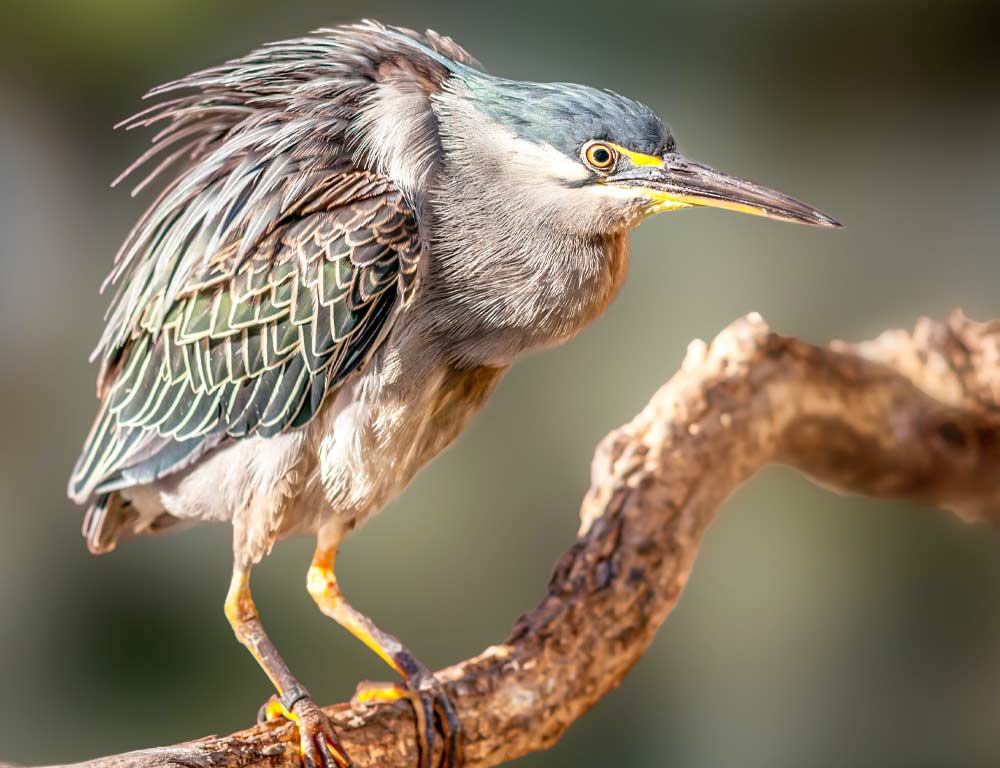
- Scientific Name: Butorides virescens
- Population: Common in suitable habitats
- Life Span: Up to 7 years
- Size: 16-22 inches
- Weight: 0.4-0.7 pounds
- Food: Fish, insects, amphibians, and small mammals
- Wingspan: 25-26 inches
The Green Heron, a smaller but equally fascinating species, can be found in various aquatic environments across Texas.
With its distinctive dark cap, chestnut neck, and striking greenish-black plumage, this heron is a master of stealthy hunting.
Green Herons often perch on branches overhanging the water, patiently waiting for the right moment to strike. Their clever use of tools, such as dropping bait onto the water’s surface to attract fish, showcases their intelligence.
Unlike some larger herons, Green Herons are solitary nesters. They construct compact, platform-like nests in vegetation near water bodies. Their adaptable nature allows them to thrive in both urban and natural settings.
Despite their smaller size, these herons play a vital role in maintaining the balance of aquatic ecosystems, controlling insect and small vertebrate populations.
3. Black-crowned Night Heron
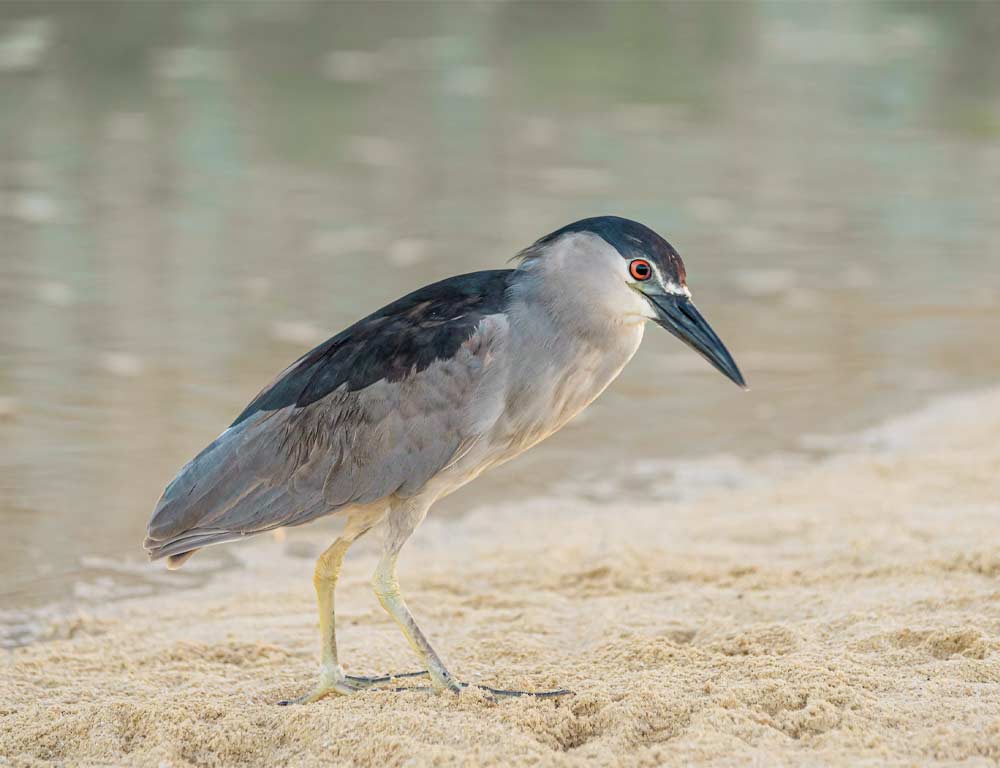
- Scientific Name: Nycticorax nycticorax
- Population: Stable in Texas
- Life Span: Up to 20 years
- Size: 23-28 inches
- Weight: 1.5-2.2 pounds
- Food: Fish, insects, crustaceans, and small mammals
- Wingspan: 44-47 inches
The Black-crowned Night Heron is a nocturnal heron species that can be found in various wetland habitats across Texas. Distinguished by its black crown and back, red eyes, and grayish plumage, this heron is most active during the evening and night.
While other heron species are busy hunting during the day, the Black-crowned Night Heron takes advantage of low-light conditions to forage for fish, insects, and small mammals.
These herons are known for their unique hunting strategy, standing motionless at the water’s edge and striking with a rapid, powerful movement when prey comes within reach.
They often nest in colonies, constructing stick nests in trees near water bodies. Despite being primarily nocturnal, these herons are adaptable and can adjust their behavior based on local conditions, making them a resilient and successful species in Texas.
4. Yellow-crowned Night-Heron

- Scientific Name: Nyctanassa violacea
- Population: Common in coastal areas
- Life Span: Up to 10 years
- Size: 22-28 inches
- Weight: 1.5-2 pounds
- Food: Fish, crustaceans, insects, and small vertebrates
- Wingspan: 39-41 inches
The Yellow-crowned night heron is another nocturnal heron species inhabiting Texas’s coastal regions and wetlands. This heron is easily recognizable with its distinct yellow crown and plumes, gray body, and red eyes.
Unlike its black-crowned counterpart, the Yellow-crowned Night-Heron prefers coastal habitats and can often be spotted in marshes, estuaries, and along shorelines.
These herons are skilled hunters, using their sharp bills to catch fish, crustaceans, and various small vertebrates. They are known for their diverse diet and adaptability to different environments.
During the breeding season, they build nests in trees or shrubs near water, creating a safe haven for their offspring.
Yellow-crowned Night-Herons contribute to the ecological balance by helping control populations of aquatic organisms, making them an integral part of coastal ecosystems.
Despite being more elusive during the day, their distinctive appearance and behaviors make them a fascinating species to observe in the varied landscapes of Texas.
5. Great Blue Heron
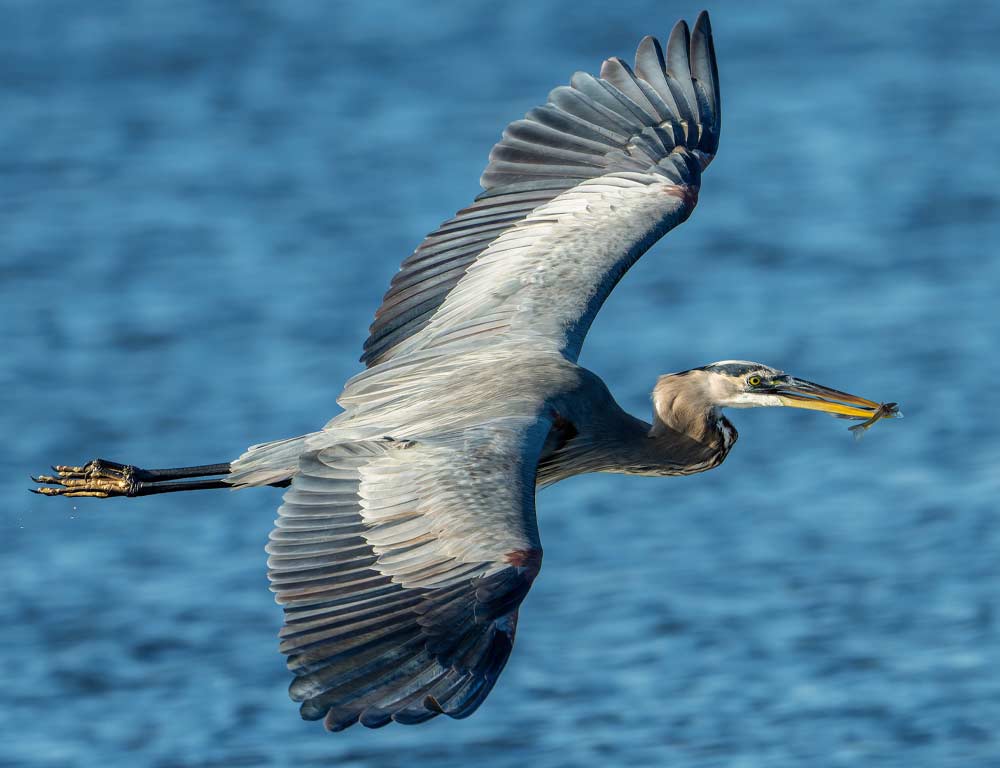
- Scientific Name: Ardea herodias
- Population: Abundant and widespread in Texas
- Life Span: Up to 15 years
- Size: 45-54 inches
- Weight: 4.6-7.3 pounds
- Food: Fish, amphibians, reptiles, small mammals, and insects
- Wingspan: 6.6 feet
The Great Blue Heron, a majestic and tall wader, is a common sight in Texas, found in various freshwater and coastal habitats.
Recognizable by its striking blue-gray plumage, long neck, and dagger-like bill, these herons are skilled hunters.
Patiently stalking their prey, they wade through shallow waters or stand motionless for extended periods, waiting for the perfect opportunity to strike. Their adaptability to diverse environments allows them to thrive in wetlands, lakes, rivers, and coastal areas.
Great Blue Herons nest in colonies, constructing large stick nests in trees. During the breeding season, their plumage takes on a more vibrant display, with elongated plumes adding to their regal appearance.
These herons play a crucial role in controlling fish populations, contributing to the health of aquatic ecosystems. Their widespread distribution and resilience make them a significant and iconic species in the avian community of Texas.
6. Little Blue Heron
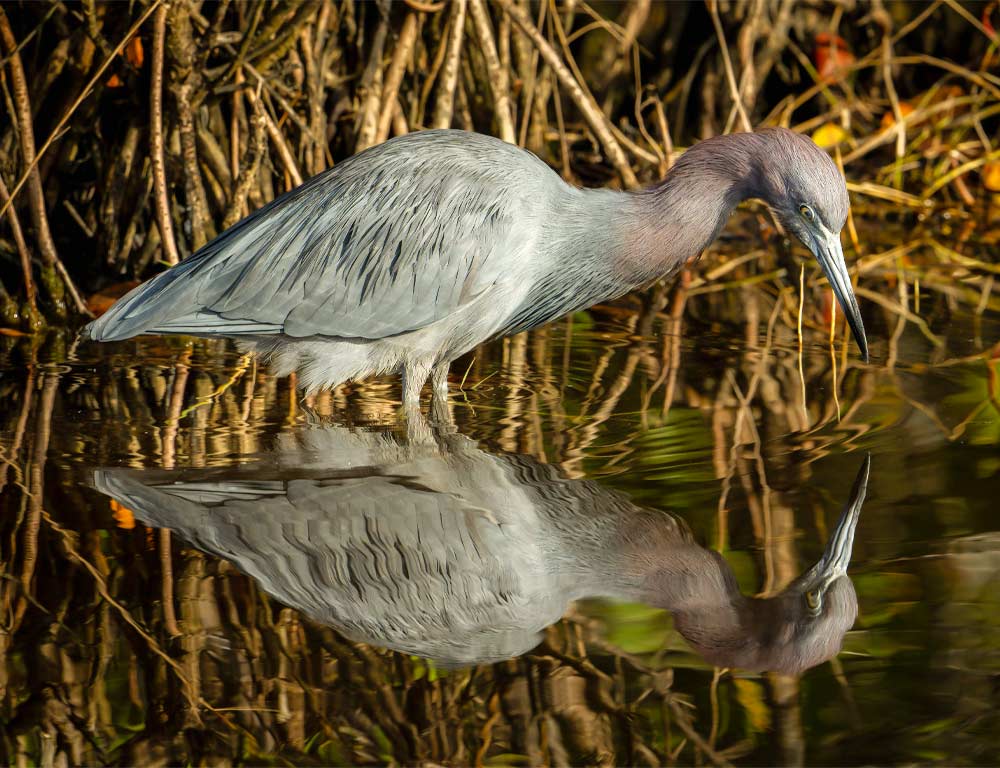
- Scientific Name: Egretta caerulea
- Population: Common in Texas wetlands
- Life Span: Up to 7 years
- Size: 22-30 inches
- Weight: 0.7-1.3 pounds
- Food: Fish, crustaceans, insects, and amphibians
- Wingspan: 3.3 feet
The Little Blue Heron, with its sleek blue-gray plumage, is a smaller but equally captivating member of the heron family. These herons are skilled hunters and are found in various wetland habitats across Texas, including marshes, ponds, and estuaries.
Unlike some heron species, Little Blue Herons are often seen actively foraging, moving quickly through shallow waters to catch fish, crustaceans, insects, and amphibians.
During the breeding season, their plumage transitions from white to the distinctive blue-gray color. They typically nest in colonies, constructing stick nests in trees or shrubs near water.
Despite their small size, Little Blue Herons play a vital role in maintaining the balance of aquatic ecosystems, contributing to controlling insect and small vertebrate populations.
7. Snowy Egret
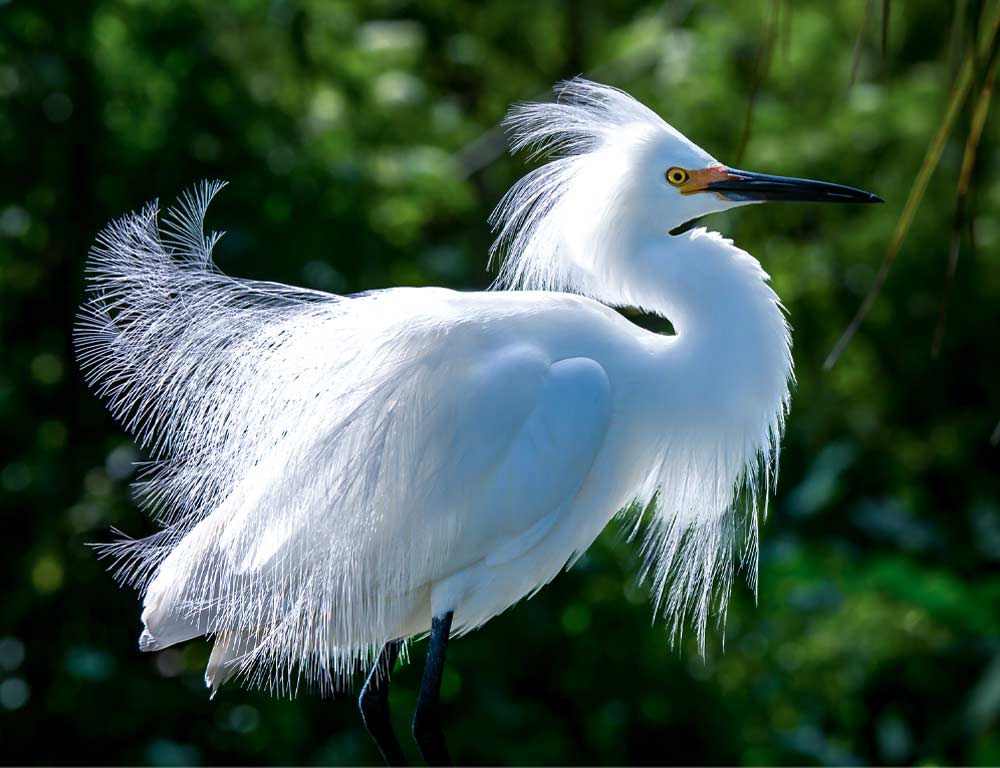
- Scientific Name: Egretta thula
- Population: Common in Texas coastal areas
- Life Span: Up to 17 years
- Size: 22-26 inches
- Weight: 0.9-1.3 pounds
- Food: Fish, crustaceans, insects, and amphibians
- Wingspan: 3.3 feet
The Snowy Egret, known for its elegant appearance with all-white plumage and contrasting black legs and bill, is a common resident of coastal areas in Texas.
With its slender build and graceful demeanor, this heron is a skilled forager, often seen wading through shallow waters or standing on one leg while patiently waiting for prey. Their distinctive yellow feet add a touch of vibrancy to their overall appearance.
Snowy Egrets feed on a diet of fish, crustaceans, insects, and amphibians. Their foraging techniques involve quick and deliberate movements, striking at prey precisely.
During the breeding season, they display beautiful courtship behaviors, including aerial displays and the growth of delicate plumes. They nest in colonies, building stick nests in trees near water bodies.
Snowy Egrets contribute to the health of coastal ecosystems by controlling populations of small aquatic organisms.
8. Least Bittern

- Scientific Name: Ixobrychus exilis
- Population: Common in Texas wetlands
- Life Span: Up to 7 years
- Size: 11-14 inches
- Weight: 2.1-4.4 ounces
- Food: Fish, insects, amphibians, and small invertebrates
- Wingspan: 16-18 inches
The Least Bittern, a secretive and elusive heron species, can be found in the wetlands and marshes of Texas. With its distinctive chestnut and black plumage, this small heron is adept at navigating dense vegetation.
The Least Bittern’s slender build allows it to move stealthily through the reeds, making it a challenging bird to spot.
These herons are primarily crepuscular, meaning they are most active during dawn and dusk. They forage for fish, insects, amphibians, and small invertebrates by slowly moving through the marsh vegetation or standing on floating vegetation, using their long bills to snatch prey.
Least Bitterns are known for their unique “freeze” behavior, stretching their neck and bill upward, blending in seamlessly with the surrounding reeds when they sense danger.
Least Bitterns build nests in dense vegetation over water, providing a secure environment for their chicks. Their secretive nature and specialized habitat requirements make them important indicators of wetland health in Texas.
Despite their small size, Least Bitterns play a crucial role in maintaining the balance of the delicate ecosystems they inhabit.
9. Reddish Egret
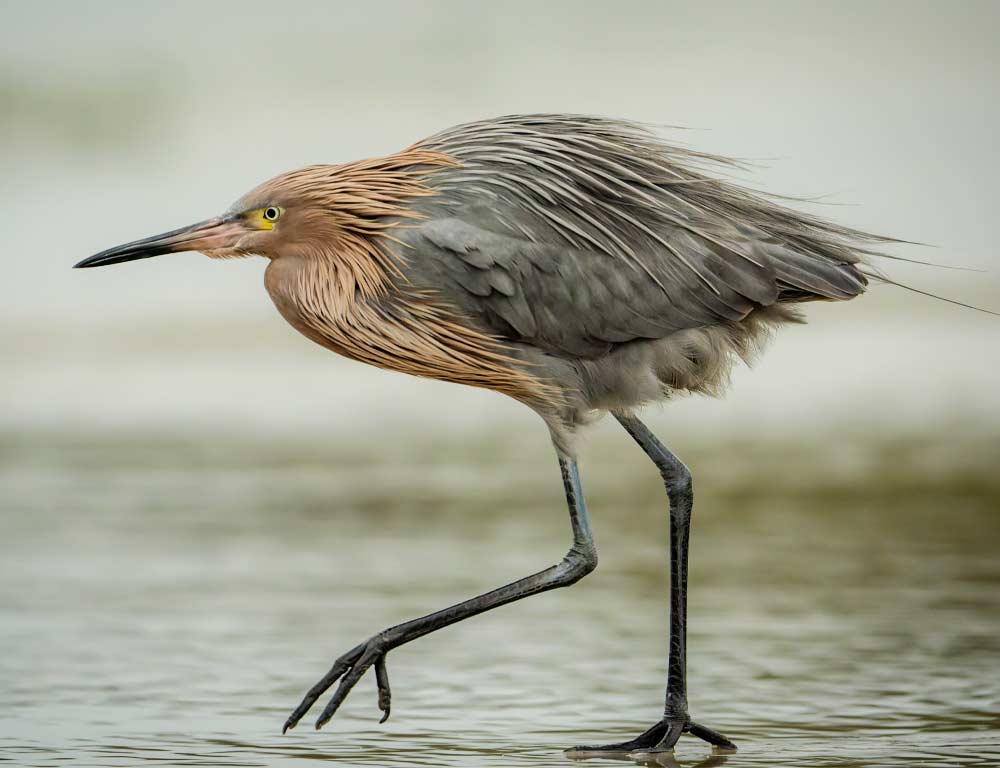
- Scientific Name: Egretta rufescens
- Population: Found in coastal regions, relatively common
- Life Span: Up to 15 years
- Size: 27-32 inches
- Weight: 0.9-1.8 pounds
- Food: Fish, crustaceans, and amphibians
- Wingspan: 3.3-3.8 feet
The Reddish Egret, with its distinctive reddish-brown plumage, is an eye-catching wader found in the coastal regions of Texas. Known for its dynamic feeding behavior, these herons employ various techniques to catch their prey.
They may dash through shallow water, leap into the air, or spread their wings to create shade, all in an effort to confuse and capture fish and crustaceans. This energetic and acrobatic foraging style sets the Reddish Egret apart from other heron species.
Despite their striking appearance, Reddish Egrets faced population declines in the past due to habitat loss and hunting.
Conservation efforts have since contributed to their recovery, and these herons continue to be a captivating presence in the coastal ecosystems of Texas. Their adaptability and resilience make them essential to the region’s biodiversity.
10. Cattle Egret
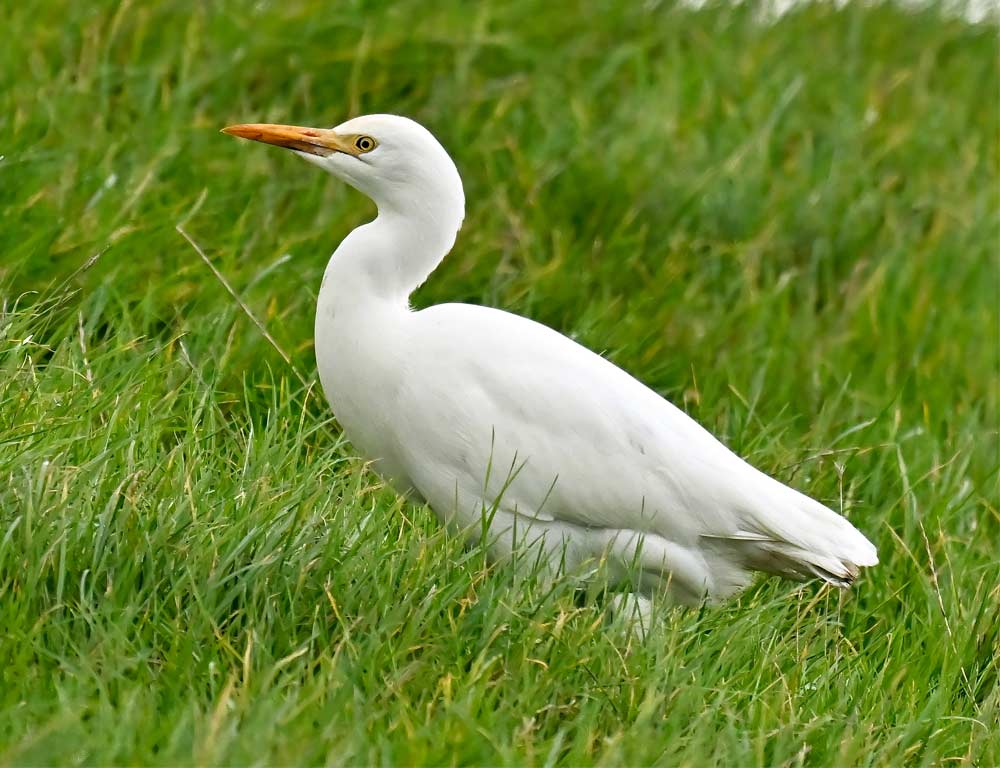
- Scientific Name: Bubulcus ibis
- Population: Abundant, widespread in Texas
- Life Span: Up to 17 years
- Size: 18-22 inches
- Weight: 0.5-1.2 pounds
- Food: Insects, especially grasshoppers and ticks
- Wingspan: 3.3 feet
The Cattle Egret is a small, white heron commonly found in the company of grazing cattle in Texas. Native to Africa, these birds have successfully spread to various continents, including North America.
Recognizable by their compact build, yellow-orange bill, and distinctive breeding plumage with orange-buff plumes on the head, neck, and back, Cattle Egrets play a unique ecological role.
These herons are often seen foraging in grassy fields, feeding on insects disturbed by grazing livestock. Their association with cattle gives them easy access to prey, primarily grasshoppers and ticks.
Despite their small size, Cattle Egrets are highly adaptable and have thrived in human-altered landscapes.
Cattle Egrets are colonial nesters, building stick nests in trees or shrubs. Their ability to exploit new habitats and form large breeding colonies showcases their successful integration into diverse ecosystems.
In Texas, Cattle Egrets contribute to pest control in agricultural areas, making them valuable allies for farmers.
11. Tricolored Heron

- Scientific Name: Egretta tricolor
- Population: Common in coastal areas of Texas
- Life Span: Up to 10 years
- Size: 22-30 inches
- Weight: 0.7-1.2 pounds
- Food: Fish, crustaceans, and insects
- Wingspan: 3.2-3.5 feet
The Tricolored Heron, distinguished by its blue-gray body, white belly, and distinctive tri-colored plumage during the breeding season, is a common resident of coastal areas in Texas.
Agile and elegant, these herons are skilled hunters, often seen foraging in shallow water for fish, crustaceans, and insects.
Tricolored Herons are known for their distinctive feeding behavior, which includes standing still and patiently waiting for prey and actively chasing and striking at fish with rapid thrusts of their bills.
Their foraging techniques are dynamic and versatile, allowing them to adapt to different conditions in coastal wetlands, estuaries, and marshes.
During the breeding season, Tricolored Herons display courtship behaviors, including elaborate aerial displays and the presentation of nesting materials. They build stick nests in colonies, often in trees or shrubs near water.
Their adaptability to coastal environments and important role in controlling aquatic prey populations make them a valuable and fascinating species in the avian community of Texas.
12. American Bittern
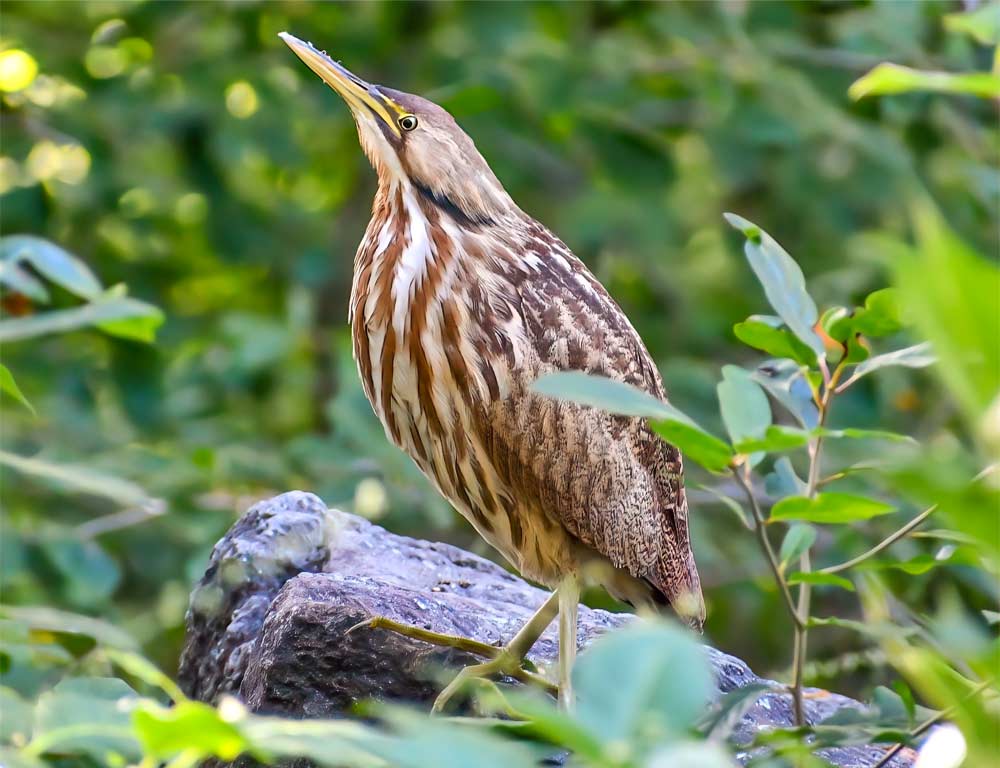
- Scientific Name: Botaurus lentiginosus
- Population: Can be found in suitable wetland habitats
- Life Span: Up to 9 years
- Size: 23-34 inches
- Weight: 1.3-2 pounds
- Food: Fish, amphibians, insects, and small mammals
- Wingspan: 3.8-4.4 feet
The American Bittern, a secretive and well-camouflaged heron, is a resident of wetland habitats in Texas.
Recognizable by its mottled brown and buff plumage, this heron is an expert at blending into its surroundings, using its cryptic coloration to remain hidden among the reeds and grasses of marshes and swamps.
American Bitterns are primarily crepuscular and nocturnal, becoming more active during dawn and dusk. They use their long bills to forage for fish, amphibians, insects, and small mammals in the dense vegetation of wetlands.
Their hunting strategy often involves standing still and slowly swaying their bodies to mimic the movement of surrounding vegetation, allowing them to ambush prey.
During the breeding season, American Bitterns produce a distinctive booming call, which serves as a means of communication and territorial display.
They build nests in dense vegetation over water, creating a well-hidden platform for their eggs.
Despite their elusive nature, American Bitterns are essential indicators of wetland health and biodiversity in Texas, highlighting the importance of preserving these vital habitats.
Best Places to Spot Herons in Texas
Texas, a haven for birdwatchers, offers a splendid tapestry of wetlands, coastal areas, and diverse habitats that attract a wide variety of herons.
Here, enthusiasts can immerse themselves in the world of these elegant waders, witnessing their graceful movements and unique behaviors.
Discover the best places to spot herons in Texas, where the convergence of nature’s wonders and avian beauty creates an unforgettable birdwatching experience.
Galveston Island State Park
Nestled along the Gulf of Mexico, this park provides an ideal setting to observe herons in their natural habitat. The marshes and tidal flats offer opportunities to witness the hunting prowess of species like the Tricolored Heron.
Aransas National Wildlife Refuge
A haven for migratory birds, this refuge is a key stopover for herons. Amidst the coastal prairies, explore the extensive trails and boardwalks for sightings of the majestic Great Blue Heron and the elusive American Bittern.
Brazoria National Wildlife Refuge
With its diverse ecosystems, this refuge attracts an array of heron species. Traverse the freshwater marshes and tidal flats to encounter the striking plumage of the Reddish Egret and the elegant hunting techniques of the Little Blue Heron.
Anahuac National Wildlife Refuge
A mosaic of freshwater impoundments and coastal marshes, Anahuac is a haven for heron enthusiasts. Witness the impressive colonies of nesting herons, including the Cattle Egret, against the backdrop of Texas’s coastal beauty.
Padre Island National Seashore
Explore the pristine beaches and estuaries of Padre Island to observe herons in a unique coastal setting. From the serene presence of the Snowy Egret to the agile hunting strategies of the Green Heron, this area offers diverse birdwatching delights.
Attwater Prairie Chicken National Wildlife Refuge
Amidst the native coastal prairies, encounter herons thriving in a unique habitat. This refuge provides opportunities to observe the Least Bittern and other heron species, highlighting the importance of conservation efforts.
Lady Bird Johnson Wildflower Center
In the heart of Austin, this center’s wetland pond attracts herons seeking refuge. The tranquil setting allows for intimate encounters with herons like the Yellow-crowned Night-Heron, offering urban birdwatchers a unique opportunity.
Jump on a journey through these carefully curated heron hotspots in Texas, where the convergence of diverse ecosystems and avian beauty creates an immersive birdwatching experience.
Wrapping Up
In Texas’s vast and diverse landscapes, the dance of herons unfolds, revealing the intricate balance of nature.
From the dynamic Reddish Egret in coastal havens to the elusive American Bittern in serene wetlands, each heron species contributes to the symphony of Texas’s avian wonders.
Exploring these prime heron hotspots, from Galveston Island State Park to the Attwater Prairie Chicken National Wildlife Refuge, profoundly connects with the state’s vibrant birdlife.
As we traverse the boardwalks and marsh trails, we witness the elegance of herons and become stewards of their conservation.
Through these encounters, Texas beckons us to embrace the enchantment of herons and cherish the delicate ecosystems they call home. Thank you very much.